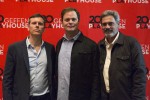An audience member hurriedly leaves the third row less than five minutes into the play, his audible excuses catching the attention of the solitary man on stage.
Thom Pain stands alone and waits for the theater door to close before swearing violently at the deserter, but doesn’t blame him. Spending an hour in his company will be far from a comfortable affair.
“Thom Pain (based on nothing),” a one-man show written by Will Eno, premiered Wednesday at the Geffen Playhouse. The play was a finalist for the Pulitzer Prize for drama in 2005 and has since been translated into more than a dozen languages, playing regularly in theaters across the U.S. and the world.
Its newest incarnation stars “The Office” actor Rainn Wilson as Thom Pain, the lonely, besuited character whose monologue recounts strange, tragic yet seemingly disconnected tales. One tells the story of a boy whose dog is electrocuted in a lightning storm and later shoves his hand into a beehive. Another is the story of his own failed love life: He pulls out a letter, reads it in teary-eyed silence then returns it to his pocket without explanation before blowing his nose.
Wilson said part of the play’s intent is to have the audience involved, keeping them guessing and leaving them in a contemplative state of mind.
“The audiences so far have been puzzled, troubled and entertained all at the same time,” Wilson said. “That’s what we’re going for.”
Wilson said Pain’s character is effectively one of a lonely loser who can’t even light his cigarette on the first try.
“I should quit,” Pain says as the audience titters.
For Randall Arney, the artistic director at the Geffen Playhouse, Pain is framed as isolated. Pain stands in front of the audience, rambling and speculating both about his life and those of the audience members. The character’s existential and psychological crises bubble over, spilling out in spasms of thoughts and phrases.
Wilson said the audience acts as a second character to the play. He said that each member has to bring their emotions and intentions into the theater for Pain to play off of.
“(The play is) like this very intense, funny, strange therapy session in a theater, with my character acting as the therapist,” Wilson said.
Among Pain’s ramblings, which Arney said veer from neurotically surgical observations about cancer and death to sadistic, random shouts of “Boo!” to shock the audience, lies one of Will Eno’s inspirations – his loneliness.
Eno said he himself was in pain and lost in the world when he sat down to pen “Thom Pain (based on nothing).” He said the other driving force behind the play was the challenge he faced with its form: trying to get as much energy, intensity and movement out of a single character on stage.
Eno has seen many one-person shows in which the lone character is one or two-dimensional. Instead, Pain demonstrates a sensitivity to how people normally talk, and contrasts it with wordier, more boring versions of a character who might show up in a regular play. Eno said in writing the play he tried to ensure that the audience learns and grows from Pain’s experiences at the same time that he does.
Wilson and Eno believe there is a fine balance in between the poetic and the conversational in one-person shows. In “Thom Pain (based on nothing)” especially, Wilson said one of the difficulties was to tell Pain’s strange stories while being open to holding a pause or gesture to allow the emotion to linger.
“Doing a one-man show is like a high-wire act,” Wilson said. “It’s like walking between the two World Trade Centers on a tightrope: There can be gusts of wind, so much can go wrong, but you need to keep moving forward.”
